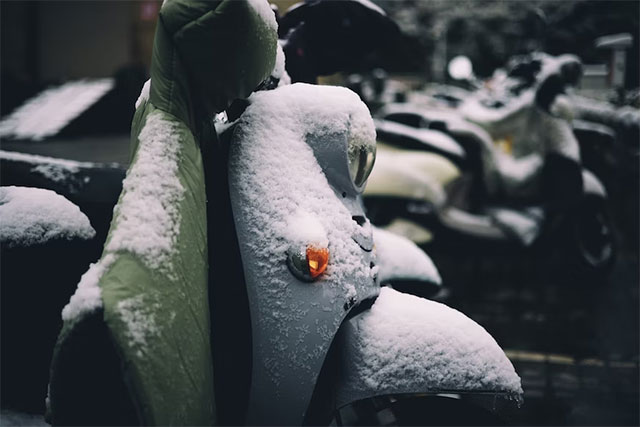Winter seasons can be harsh for all vehicles, including motorcycles. As a motorcycle owner, it’s your responsibility to maintain and take care of your vehicle during this weather. If you’re winter driving, you must ensure your motorcycle is in working condition and safe.
Maintaining your motorcycle is always essential to prevent road accidents and injuries. Like many vehicles, motorcycles need extra care in cold weather, especially when the conditions are severe. When the winter season starts, you shouldn’t wait until the first snowfall to do your winter maintenance.

If you’re a first-time motorcycle owner, read this winter care guide to ensure your vehicle’s optimal performance.
Table of Contents
Check the Battery
Motorcycle batteries can experience strain in cold conditions. This strain is usually caused by thick engine oil and increased electrical usage on lights and bar warmers. So before storing or riding, check the battery.
During battery check-ups, start by checking the voltage. A healthy motorcycle battery should have a voltage of 12.6 VDC. If it’s below this level, recharge and allow it to rest. After resting, test again.
If the voltage reads between 12 to 12.6, it’s not fully charged. When the battery’s full, grease the terminals and ensure everything’s tight and clean for storage or the next ride.
If the battery drains quickly, consider a replacement.
Inspect the Tires
Tires play an essential role in your motorcycle’s load capacity and maneuverability. Extreme temperatures and winter weather can strain the tire treads, resulting in grip problems on wet, slippery, and frozen roads. Tire pressure can also impact your tire health.
Tire inflation levels can drop two pounds per square inch (PSI) for every 10-degree temperature drop. Before heading out, make sure your tire pressure is within the standard levels of 28 to 40 PSI. You can find your motorcycle tires’ recommended PSI in the user manual or on the placard.
Additionally, it’s best to change your tires to winter-grade ones for better grip and handling on snowy and icy roads.
Utilize Quality Coolant and Antifreeze
Cooling systems are components that prevent your motorcycle engine from overheating. They use coolants and antifreeze to maintain optimal temperatures.
Different types of motorcycles may require specific coolants and antifreeze. Remember to use quality ones and ensure they’re filled properly. For winter, you’ll need an antifreeze with a low freezing point (at least -30°C) to prevent the system from freezing when parked. Never use water to fill the cooling system.
Lubricate the Chain and Other Moving Parts
Dirt, oil, snow, moisture, and ice can mess up your motorcycle’s chain and other moving controls, including brakes, throttle controls, and pedals. Lubricate them regularly to prevent rust formation, protect against freezing, and ensure smooth operation.
Change the Oil and Filter
Motorcycle engines can be rusty due to moisture build-up. Whether you’re storing or riding your motorcycle in winter, you must change its oil and filter. Cold conditions can affect oil consistency, so you should use an oil that works best in winter. Changing the oil and filter before winter starts is preferable to ensure engine protection.
Clean After Every Ride
Cleaning your motorcycle after every winter ride can be time-consuming, but it helps prevent wear and tear. Hose your motorcycle down with water. Focus on cleaning the undercarriage, wheels, gaps, and crevices where moisture, snow, ice, or salt can accumulate.
There’s no need to wash it thoroughly, as hosing after every ride can be enough. You can do a thorough cleaning every one or two weeks.
Don’t forget the lights. Wipe your lights before and after each ride. It’s also best to carry a cleaning solution to clean every light whenever you stop or park.
Apply Anti-Rust Spray
After cleaning, apply an anti-rust spray to your motorcycle’s undercarriage, gear pedal socket, brake discs, and other vulnerable parts. Anti-rust spray can help create watertight barriers to prevent corrosion. You should apply it regularly.
Store Indoors Where Possible
Indoor storing is the best way to keep your motorcycle safe during winter. It can help reduce the impact of cold weather on the battery and engine. A secure shed will do if you don’t have an enclosed garage. If it’s impossible to store your motorcycle indoors, use a high-quality tarp to cover it.
Install Hand Warmers
Winter riding can be tough on your hands, even while wearing high-quality winter gloves. To protect your hands, install hand-warmer grips. These inserts can fit on standard grips. They use battery power to keep your hands warm. You may use lever wraps or sleeves, hippo hands, and heated gloves if hand-warmer grips are unavailable.
Treat the Visor
Helmet visors can accumulate mist that can impair your vision while driving. You may apply anti-fog coatings or use stick-on inserts to prevent moisture build-up. If you opt for the coatings, remember to reapply them to stop fogging while riding.
Protect Your Motorcycle During Winter
Maintaining your motorcycle during winter is not just for road safety. It will also help you avoid the legal consequences of causing winter-related accidents. Motorcycle accident lawyers‘ defense may be insufficient if you engage in illegal driving activities and there’s strong evidence against you. It’s not worth the risk, so be a responsible motorcycle owner.












